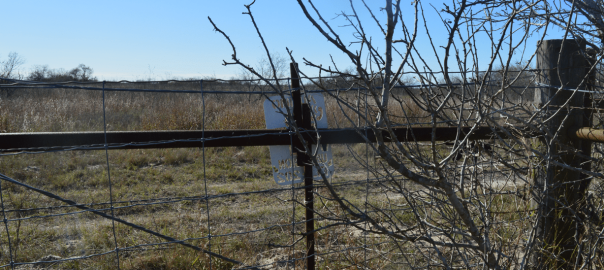The 6:45am alarm goes off. I turn it off and close my eyes. My body suddenly jolts, I had fallen back asleep for an extra 5 minutes. My teammates and I get up and start pulling out clothes and packing our bags. It is 38 degrees outside this morning. The high will only get up to 56 today, a stark difference from the day before which reached 90 degrees. After chugging our Vitamin C packet Dr. Latham gives us every morning at breakfast, we layer up in extra flannels.
Today’s plan is to return to the same ranch we searched yesterday. Don wants us to thoroughly search a new area to find out if there is any evidence of migrant activity less than about a year old. This, we learned, would help him determine if this area is a path that coyotes alternate using when they bring migrants through Brooks County. This part of the ranch has never been searched before, and since it is so large, it is crucial to have our group assist him. We anxiously await for Don and Ray to meet us so we can load up in the trucks and head off.
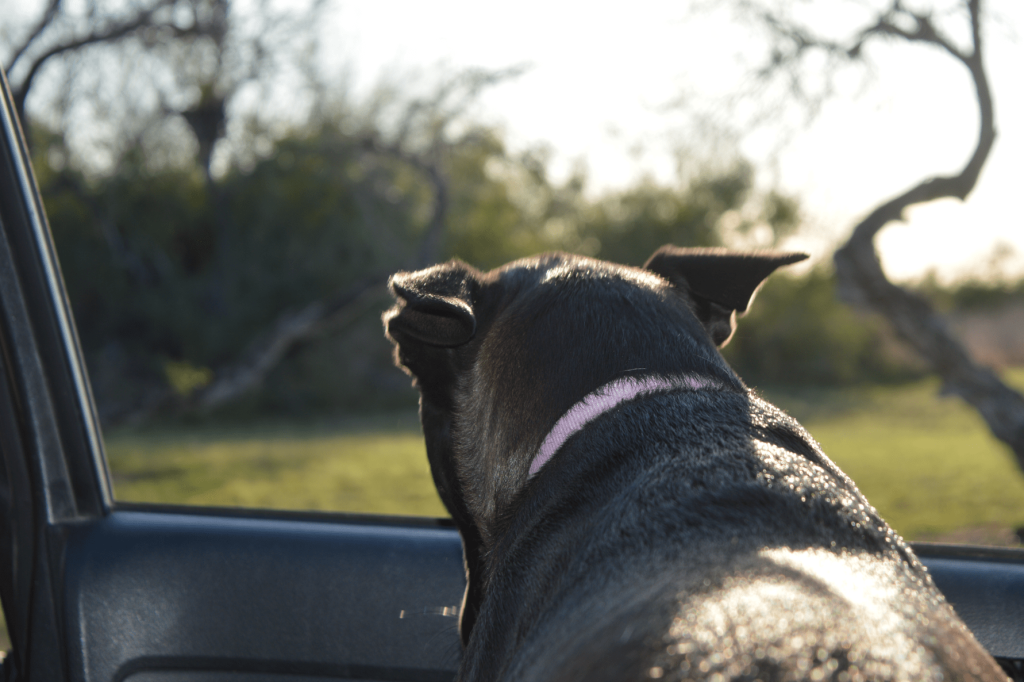
This ranch has the same two-lane road next to the fence line that separates it from another ranch as we saw yesterday. The vegetation in this area has many dense and thick MOTs. Becase of the dense brush, migrants tend to walk along a path in areas like this. We learned that even though the sand may hold footprints, the winds the past few days have been strong enough to completely remove such evidence within hours. Our task today is to search along the road and slightly into some of the brush and trees in the periphery, which is where migrants would likely take a break and potentially leave items behind.
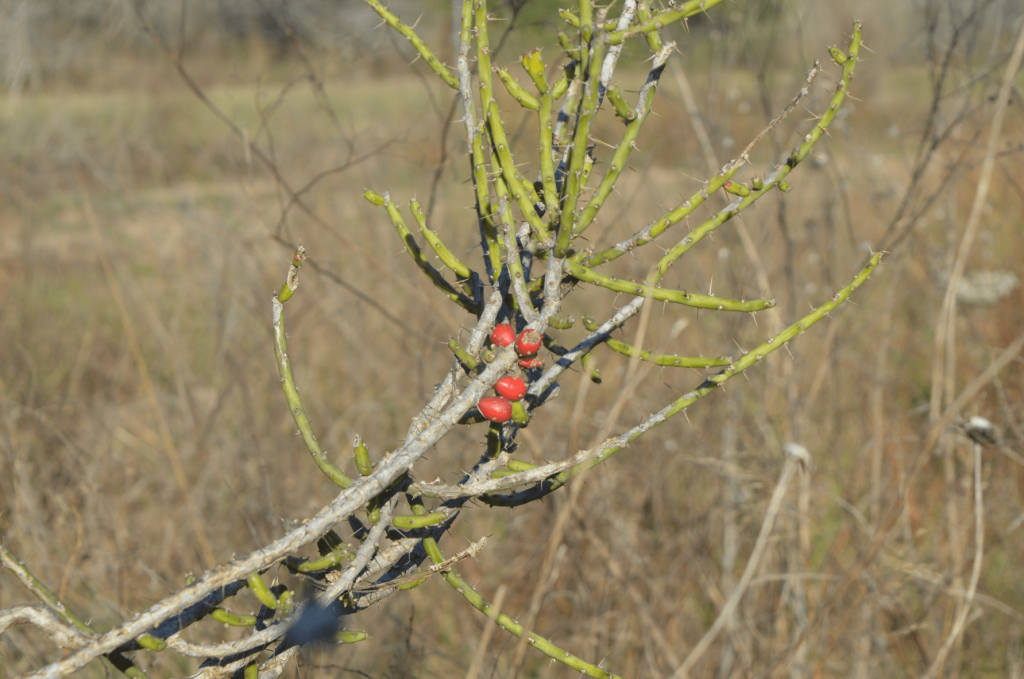
After taking our pre-day picture shivering in the morning air and we are off. First we start in a vast field of tall grass that goes up past our hips with a dense treeline to the east. Using a “buddy system,” we paired into three groups to easily keep an eye on each other. In the treeline, Makenna and I had to weave in and out of thorny tree branches which grabbed our clothes and hair while also dodging deceptively camouflaged pencil cacti. While searching, we observed areas where traveling migrants would potentially rest, but most did not show evidence of recent use. While searching in a MOT, I moved a low-hanging thick branch and thinking nothing of it, I then walked inside to search. It was not until I came back out with my buddy, that Ray came up to us to let us know we needed to pay attention to where we were going and be more aware when we move branches. Turns out that the branch I moved was a dead limb barely hanging above us and when I had moved it, it nearly came loose and could have fallen and hit Makenna. The possibility that this could have happened caused a deep fear and anxiety in my stomach. I don’t know what I would have done if I had been responsible for causing someone to get hurt. Getting injured out here is so easy (our many bandaids have proven that). I can’t imagine what a migrant might have to face after getting significantly hurt while traveling and under the complete mercy of a guide. According to Don and Ray, more often than not, they are abandoned by the group and literally left for dead.
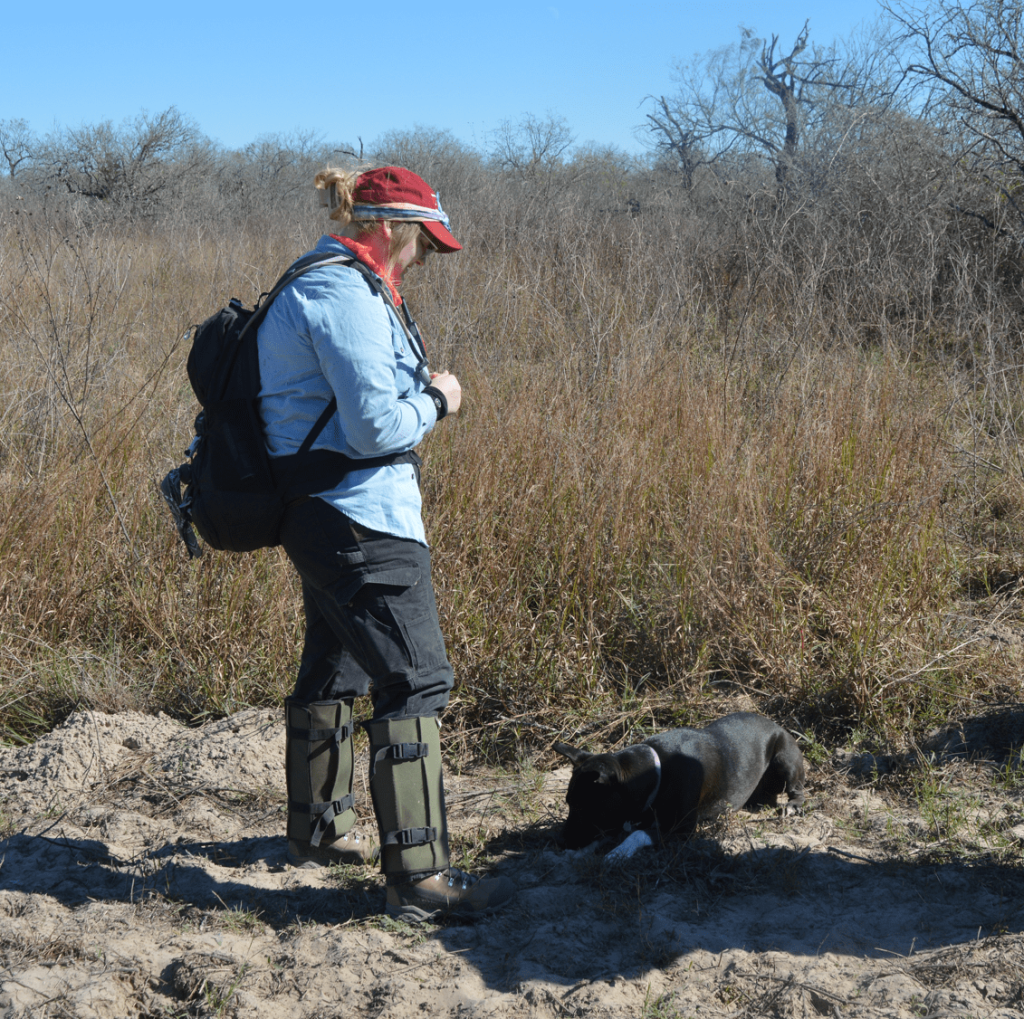
We continued searching and found a few items. Most common were cans and plastic bottles but many were not recent. Occasionally we saw mounds of non-human skeletal remains, including nilgai, hog, deer, and coyote. Ray was keeping a watchful eye on us all while we were searching with our buddies. Meanwhile, Don was off with socks searching ahead. Occasionally you’d hear him singing a lyric over the walkie to check in on us, with members responding back with the next verse. Finally when we were out of MOTs Don had returned to lead us to an area with some things he wanted to show and explain to us.
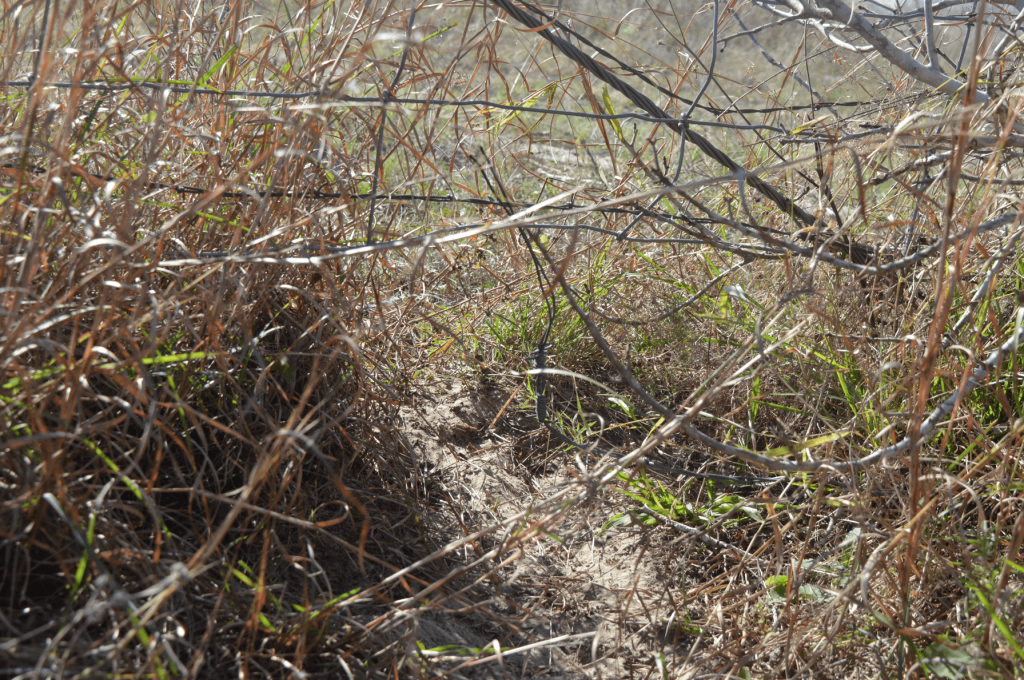
We proceeded to walk down the sand road which was so hard to walk on in our heavy pants, boots, and gaiters. Finally, we reached a corner of the ranch where 3 ranches met. Here Don showed us a gap dug under one of the fences. We learned that typically these are dug by wild hogs and then, opportunistically, other animals and groups of migrants will use them to cross into different ranches. This gap just so happens to be placed directly next to an emergency 911 sign. These metal signs are made and placed around some ranches to provide a number for migrants to call if they are in distress. These are accompanied by a number they can give while calling which will notify authoriites exactly which sign they are located at. Many of the calls Don and other organizations get are approximate coordinates. Coordinates, no matter what instrument you use, are widely inaccurate. Thus when border patrol or Don goes out to search for the individual they are usually not at the actual coordinates provided. About 100 meters from this site, in the distance we could see a satellite emergency beacon. It makes me very relieved that things like these exist but it’s important to note, this is the first one I’ve seen in the ranches I’ve been to this year and last year, meaning they are not super common. If a migrant is in distress they likely won’t make it to an area with a sign or satellite. I can’t help but think of how many lives could have been saved if these were more common.
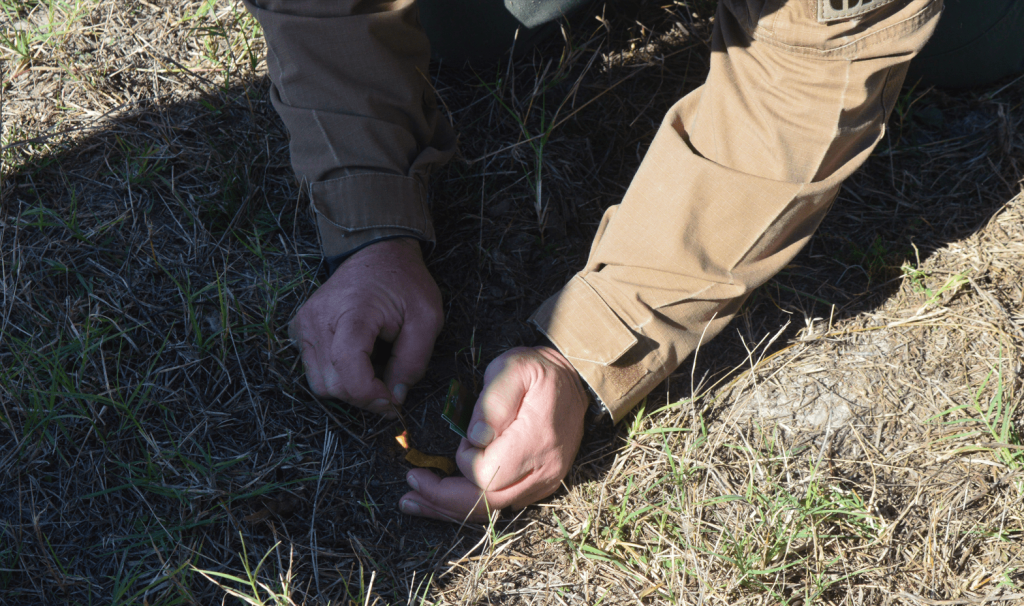
During our lunch break, Ray taught us a survival strategy in which Fritos can be used to start a fire. We all laughed thinking this was a joke like always, but Ray proved it to be true, proceeding to light a Frito on fire with a simple match.
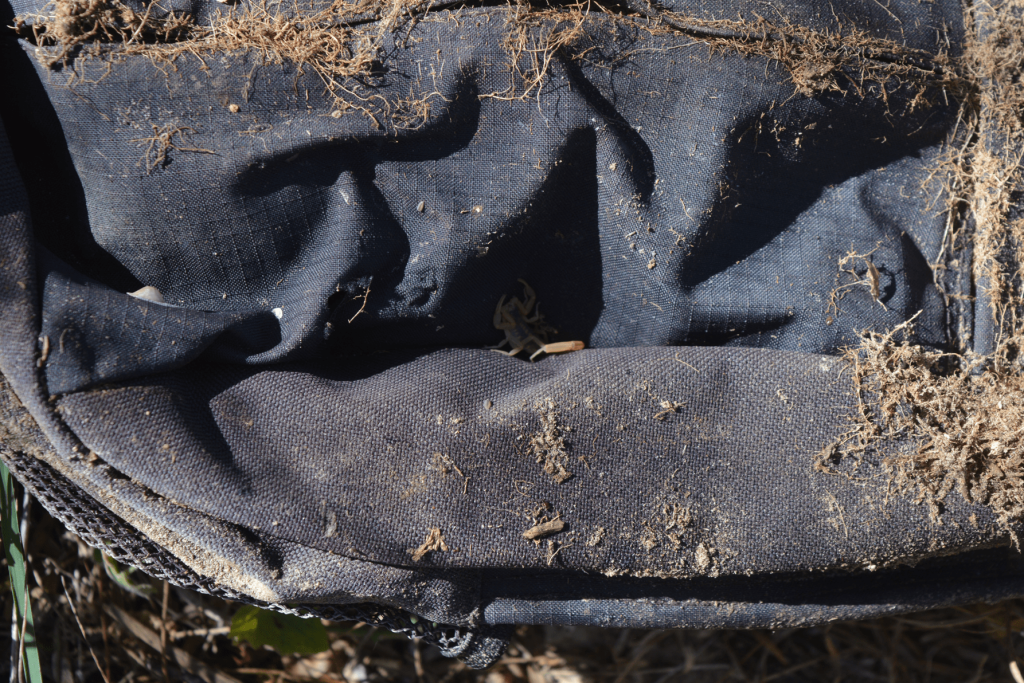
With full bellies and some newfound knowledge, we got back to searching more of the sand path and treeline next to it. We split with new buddies and began to find similar trash spread sporadically. Again, nothing suggested recent travel. It was then Lilly and Dr. Latham came across a backpack with a few cans. We gathered around, but as Lilly was picking up the bag to cut it open, a live scorpion caused her to drop it. Ray came over and picked the scorpion up with his knife and flung it away. Cutting the bag open revealed nothing but an obviously weathered shirt which showed the bag was there for a while. Soon after Don decided to conclude the search. We had successfully searched a large portion of land on a ranch that hadn’t been searched before. One more place Don can check off his list.
We drove back sharing stories about ourselves in the truck. I really value the times we all can take time away from the seriousness and heaviness of our searches and bond with each other and Don and Ray.
We departed Don and Ray as they needed to file a report for the recovery we did on Saturday with the JP or Justice of the Peace. It is similar to a coroner in other states but a JP has FAR more responsibilities which has proven to be overwhelming, especially with counties dealing with the migrant crisis like Brooks County. Although it is not on the border it has one of the highest rates of death of migrants due to the border checkpoint.
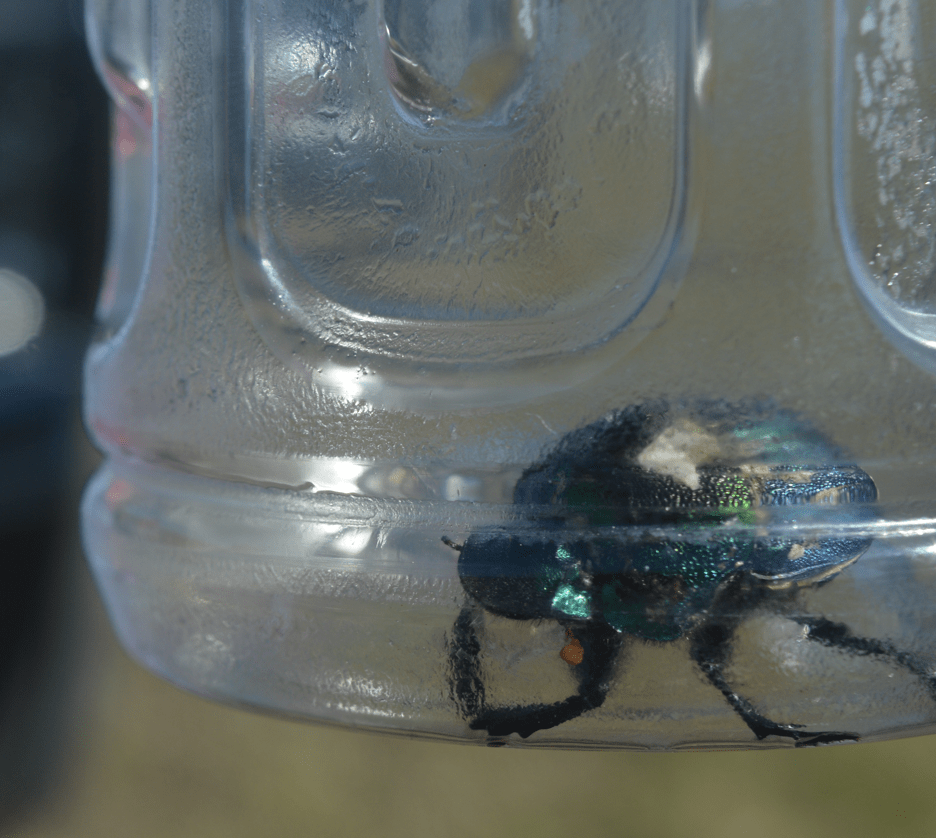
After changing we were able to take a small break to relax and decompress in our hotel room. Being down here in Brooks has allowed me the opportunity to try new things, which I don’t do very often, and I am thankful to come back and experience more new things. This includes food like Sour Pickle Balls. Frankey and Lilly tried them, which resulted in an overwhelming spicy and sour taste and the unfortunate side effect of making their mouths and teeth a deep blue. After our short break we started our hour-and-a-half journey down to see the wall that separates the US and Mexico. We listened to music, watched the scenary chnage as we moved south, and talked about the day.
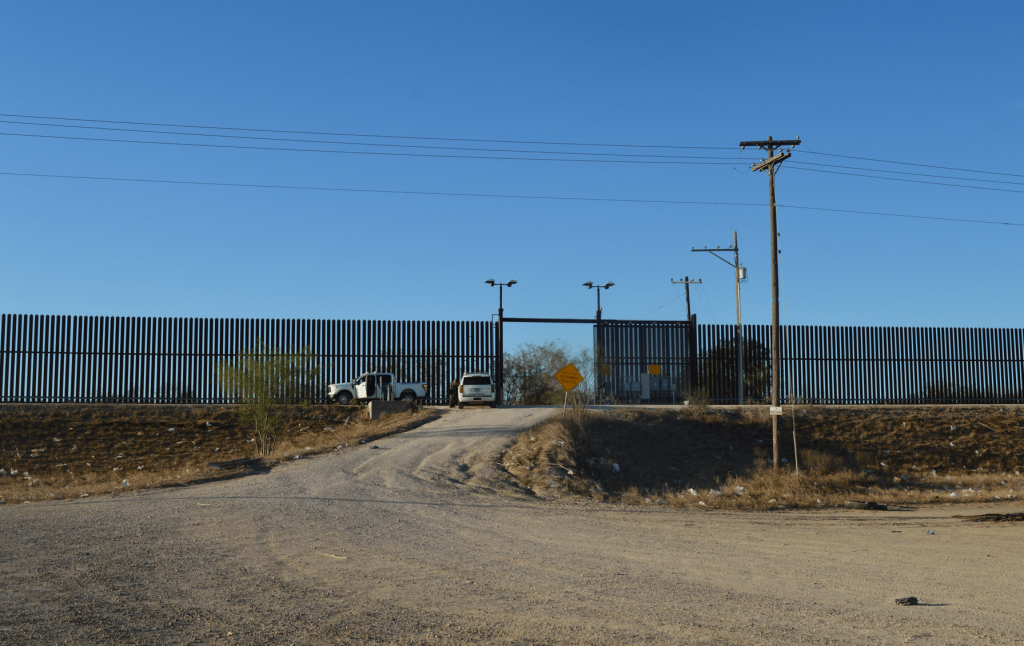
When we arrived we came upon a vast urban area full of many businesses and surrounding residential areas. For some reason, I never thought there’d be a large city right along the border and a bridge to Mexico. I always pictured the environment we saw on the ranches spanning for acres and all of a sudden a huge wall, but this wasn’t the case. While driving we saw the massively tall wall in the distance. Further, though, it switched to a chainlink fence which I thought was weird at the time. We were no more than half a mile from Mexico.
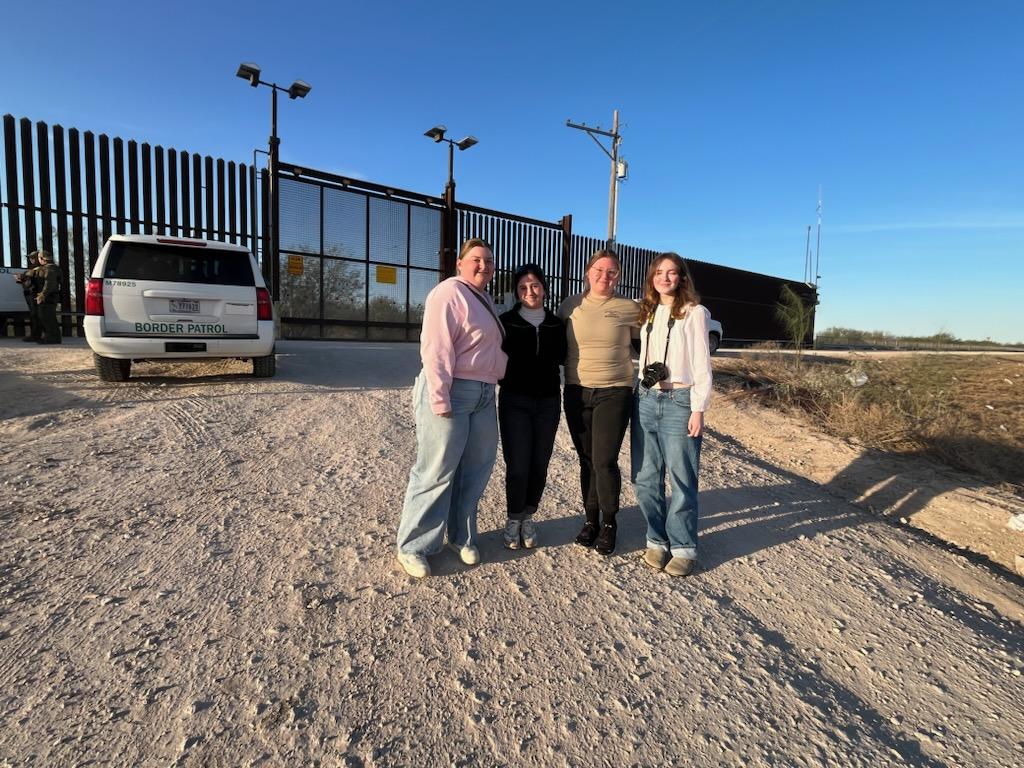
We were able to park at the base of the wall where a gate was located with multiple border patrol cars. We walked up and Dr. Latham introduced our group and we had the opportunity to talk to an agent there and ask questions. The border patrol agent we talked to was originally from Maine and he was stationed at the northern border between the US and Canada. Here we learned the reason the wall switches to a smaller fence in places is because on the other side there is a 15ft drop. Depending on where you are the wall looks different, with some parts newer than others. Likewise, we learned that border patrol doesn’t station people at a specific spot all the time. Typically they just patrol except for some high-traffic places. The border patrol agent told us the majority of what he has seen here is “turn in traffic” rather than chases. This means people will turn themselves in and seek out border patrol. Dr. Latham tells us that they will do this to declare asylum or if they are in distress. The agent is an EMT and works to take care of people in distress. He placed great emphasis on the fact that he checks on children first because they are smaller and may not handle the environment, climate, and trek nearly as well as the adults they travel with.
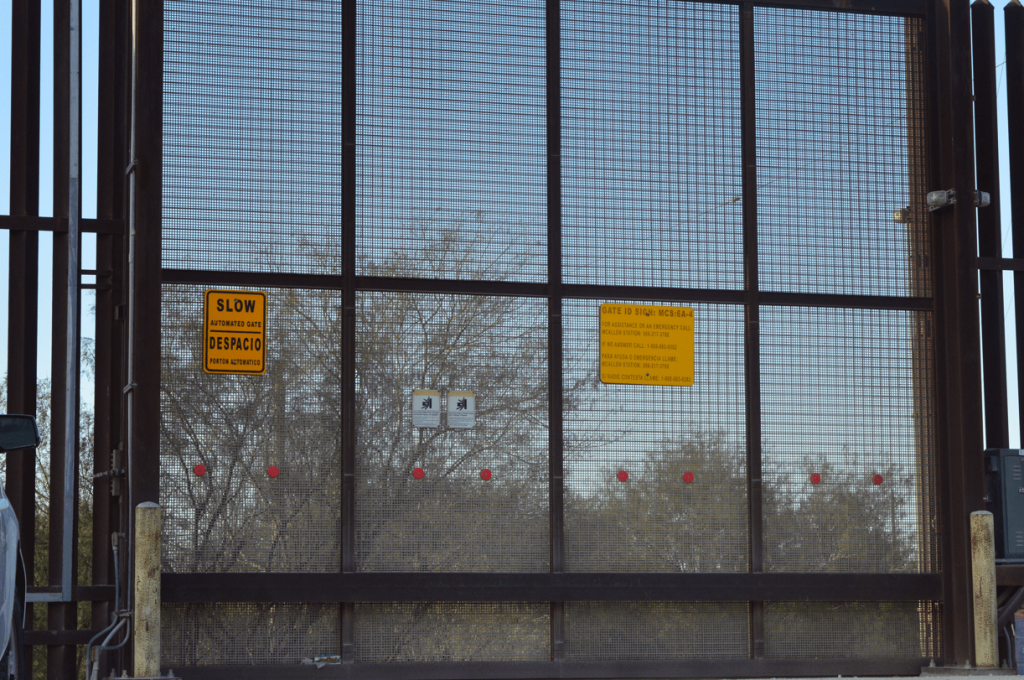
While we were talking, the gate opened and a white and green border patrol truck pulled through and parked on the bank with two individuals riding in the bed of the truck. They help each other out and then are led to a place by the gate where they could sit and wait. Watching this made me feel so guilty and ashamed to be observing this serious moment like a tourist with camera in hand. I am so privileged to be born into the family I was. Why must someone struggle so much to escape one life to cross the border into a country where it is not guaranteed life will be any better? I was always told growing up that life isn’t fair, but in the context of the prolonged mass disaster at the border, it’s something I absolutely cannot get over. Dr. Latham said they probably turned themselves in to seek asylum. Seeing this made the crisis so much more real. There is likely high traffic right now because the right to seek asylum is still in effect under the current administration but with the new administration, border policies may change.
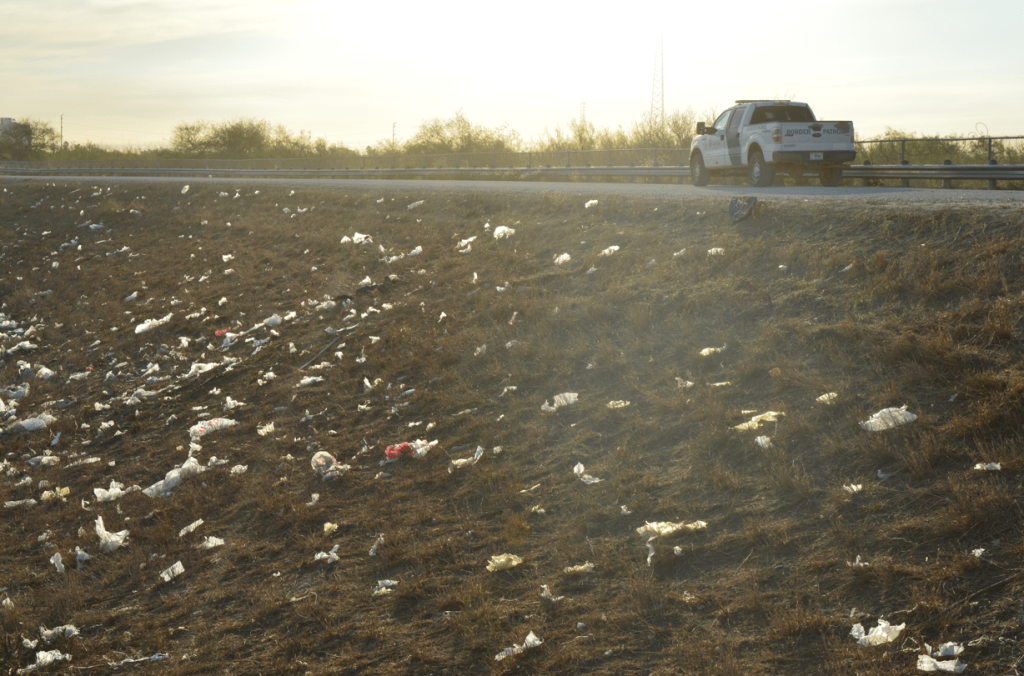
As we were leaving, we walked down the path where I noticed the trash littering the hill on both sides. There was clothing, bottles, bags, water jugs, and right by the road: a ladder perhaps used to climb over the wall. As we pulled away, I was able to reflect that this was a defining moment for me and an opportunity I never would have been able to experience without Beyond Borders.
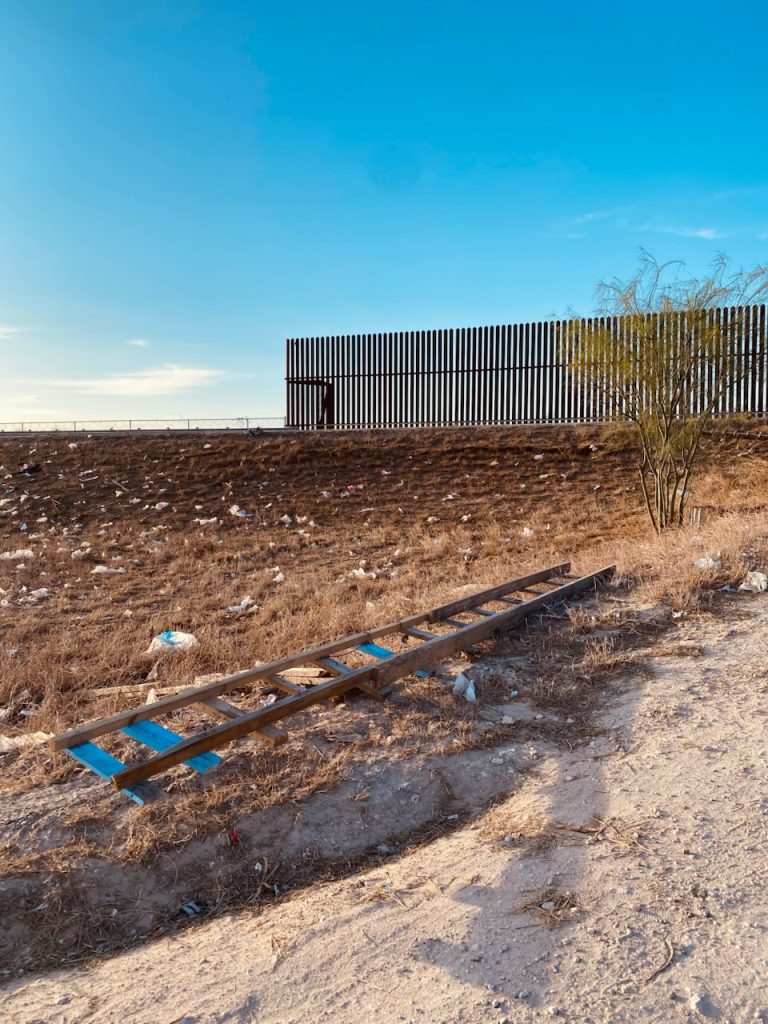
We started driving back and decided to stop at Dr. Latham’s favorite tamale restaurant only located in South Texas: Delia’s. We ordered two dozen tamales and two of us got to try them for the first time (P.S. You’re not supposed to eat the husk if you didn’t know). Thoroughly satisfied and mouths on fire, we got back in the car to drive back.
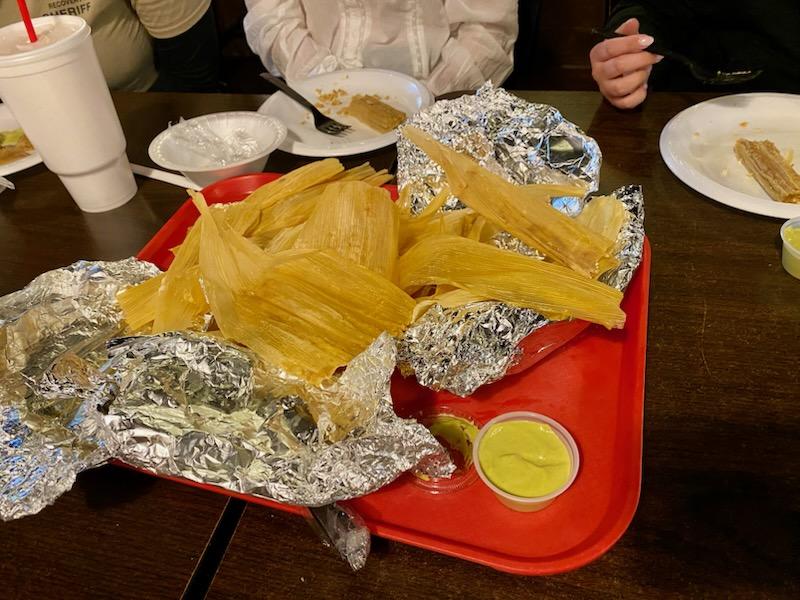
When we arrived we had our nightly debriefing. Although we didn’t have as many recoveries as last year, I had to remember that this trip was completely different. Last year every ranch we went to we had coordinates showing there was someone there at some point. This year we took on a role of more searching for activity and general clearing of areas for Don. This trip was just as successful, just for different reasons.
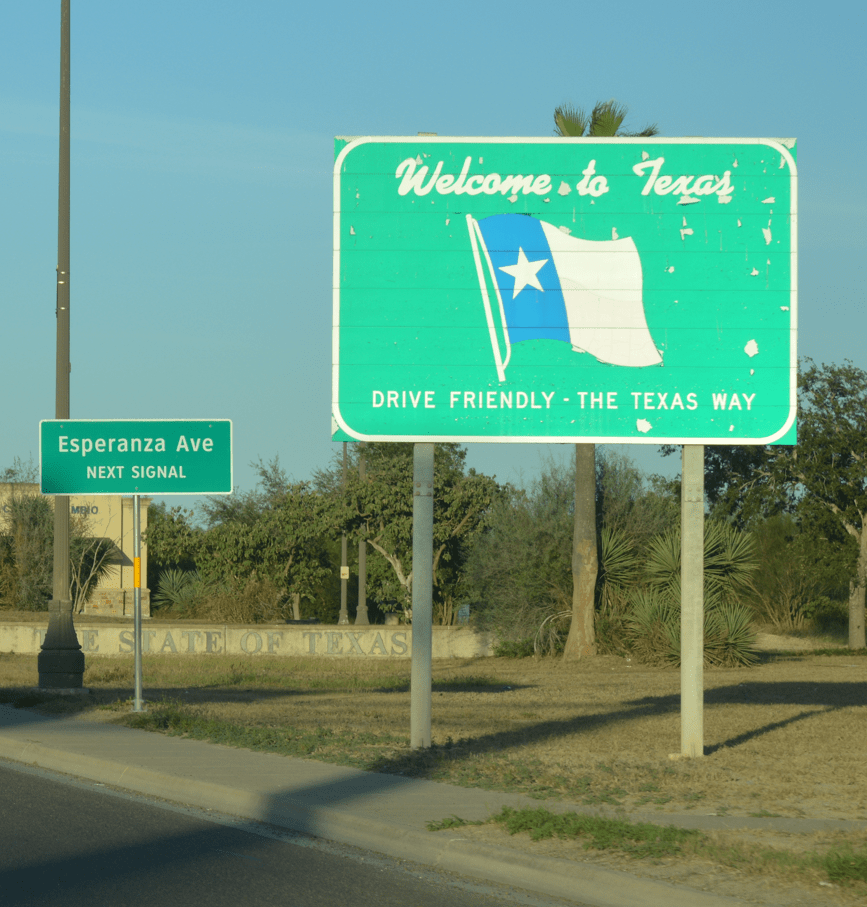
Fully realizing that tomorrow will be our last day, we returned to our room to make sure we got as much rest as possible. Recovery or not, I will never forget this experience, and I’ll cherish every single moment.
